Penon Impact Review
By Nick Smith, 10th March 2023
Recently I was watching an old Star Trek: The Next Generation episode entitled The Measure of a Man, which led me to ponder the subjective nature of our hobby.
In the episode, Captain Picard struggles to verbalise why disassembling an android crewmate would be -forgive the pun- inhumanly cruel as he wrestles with the notion of precisely what makes us human. Often things we feel in our bones can be strangely difficult to articulate.
Which brings me to what on the surface feels like a simple question yet is anything but: “what makes a great pair of earphones great?”.
Ask any ten Head-Fi’ers and you may receive ten slightly different answers.
Yet if the question changes to “what is the greatest set of earphones?” over the past three years Head-Fi’s most common answer has been the Oriolus Traillii. Equally famous for their smooth, rich sound and USD $6000 pricetag, Traillii achieved an almost universal appreciation rarely seen in the hobby.
Having demoed Traillii last year (thanks to Damz87) and beeen suitably impressed, my ears immediately pricked up when in January Penon Audio released a much more affordable IEM called the Impact, who’s frequency response graph matched Traillii’s almost identically. I reached out to Penon to signal my interest, asking if they’d consider providing a discount if I wrote a review of the Impacts – and they agreed.
What you’re about to read are my resulting findings.
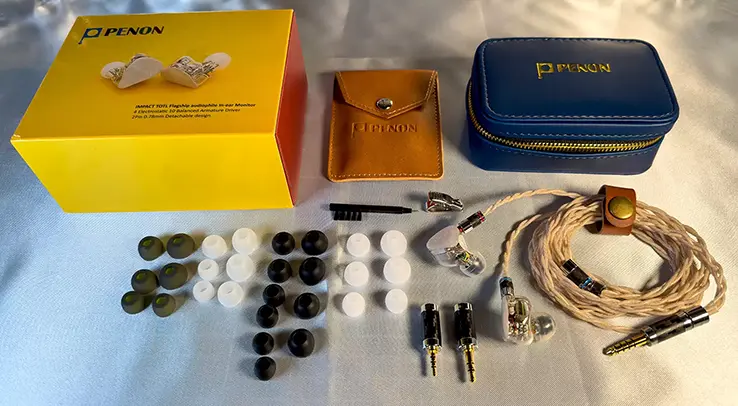
Box Contents
Penon Impacts are a set of 4 EST + 10 BA hybrid IEMs retailing for USD $2500, available in both universal & custom shells.
Each Impact comes paired with a white 2pin Obsidian cable, utilizing OCC & gold-plated OCC cores and featuring a modular plug with 4.4mm, 2.5mm & 3.5mm terminations.
Included in the small cardboard box the Impacts arrive in is a leather carry case, leather accessories case, shirt clip, IEM cleaning tool, and 4 sets of eartips – one of which are JVC Spiral Dots.
As a Head-Fier who routinely buys & sells equipment and rarely keeps anything longer than six months, unnecessarily large & heavy boxes (and their lavish ‘unboxing experiences’) have gradually become the norm for IEMs at higher price points.
So it is with decidedly mixed feelings I greet Penon’s minimalist approach to the Impacts’ packaging. On the one hand if I decide to move them on they’ll cost far less to ship internationally or by courier than they would in a cumbersome wooden or metal box.
However one expects a certain level of quality when larger numbers are involved, and this appears to be the same box & leather case accompanying Penon’s $299 Serial IEM. Furthermore the stock Obsidian cable sells separately for $150, in contrast to more expensive cables often bundled with IEMs from established high-end brands. The Impacts are Penon’s first entry into this much higher price bracket and I see this as an area they can stand to improve in future.
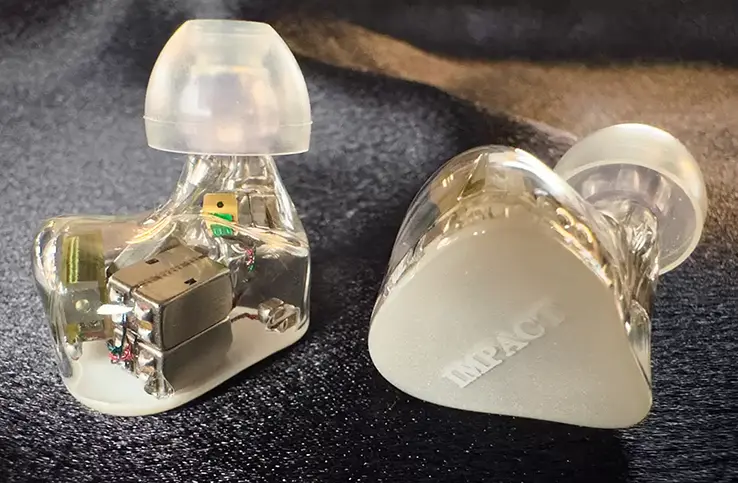
Appearance & Ergonomics
The Impacts are housed in clear resin with internal components plainly visible. Ear fit is a very personal thing, but I’ve found them to be one of the most comfortable IEMs of this size, which is slightly larger than Traillii but considerably smaller than IEMs like Jewel, Multiverse Mentor & Elysian X.
Impacts’ shells are extremely smooth and feel great against the skin. The 2pin sockets are not recessed but sit flush, the stock Obsidian cable is weighty by 4 wire cable standards at 41 grams, does not have moulded earhooks, and its’ PVC insulation is slightly rubbery but nothing out of the ordinary.
As you can see from the photos the Impacts’ have minimalist white faceplates with a subdued sparkle only visible up close, with the word Penon on the left shell & Penon on the right. Design is always subjective but they’re quite a shift from the brightly coloured, attention-grabbing faceplates we’re often greeted with.
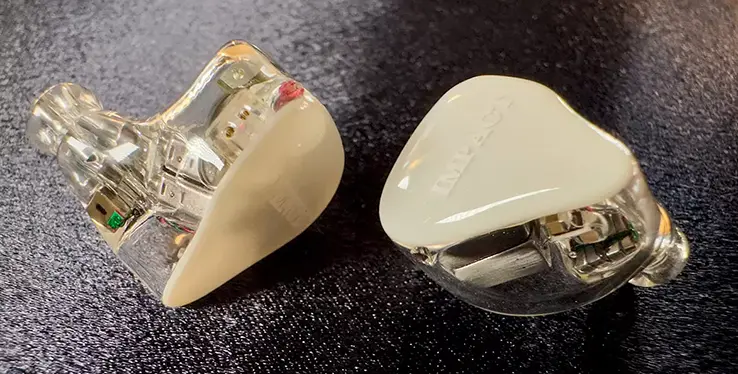
Sound Impresssions
If you’ve heard Traillii, Impacts are cut from the same cloth but are not identical. They feature a very rich & prominent midrange which is the focus of their presentation, somewhat elevated bass (subjectively more than Traillii by some accounts, but I did not have Traillii on hand to verify this), and detailed but tastefully subdued treble.
From a technical perspective, Impacts are quite dynamic, possess a wide soundstage (reputedly slightly narrower than Traillii’s) with terrific imaging & separation and are superbly resolving.
They do a great deal right, but it’s often easier to characterise IEMs by what they do wrong. In Impact’s case very little stands out as manifestly inadequate, depending on your preference the sole exception may be the absence of a Dynamic Driver.
Impact’s BA bass is superb by BA standards – being quite textured, fast and present in enough quantity to make EDM extremely satisfying, but the slower decay & slam of a DD isn’t something BA’s can hope to replicate. I would nominate Impact’s BA bass of the best attempts so far but some Head-Fiers insist on DD bass and will accept no substitute.
To better convay Impact’s sound I compared them with a number of IEMs from similar price brackets.
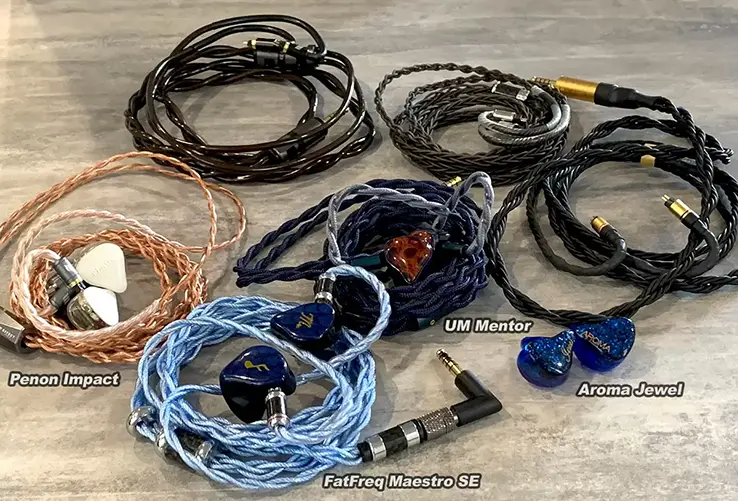
IEM Comparisons
Last Saturday I attended a Melbourne Head-Fi meet with Damz87 , lycos and jaydoc1, using the opportunity to compare the Impacts with other IEMs present. All comparisons were made on my Cayin N8ii in Tube Mode with P+ enabled, and the Impacts were paired with an Effect Audio Ares S cable due to an issue with the stock cable. Spinfit W1 eartips were used on all IEMs tested.
FatFreq Maestro SE (USD $1900)
MSE’s shells are huge. Slightly bigger than Mentor’s with unusually-shaped nozzles I didn’t find terribly comfortable. I could live with them but would need to keep listening sessions under a few hours.
Requiring almost double the power of Impact to reach similar volume, MSE’s blue ‘upgrade’ cable was also noticeably heavier than any stock cable of IEMs present, including Mentor.
MSE’s have quickly become famous for their insanely elevated DD-powered sub bass, yet somehow accomplish it without adversely affecting the rest of the frequency spectrum. As such there is simply no comparison between MSE & Impact where bass quality & quantity is concerned, though MSE’s will be too much of a good thing for some.
In other departments MSE’s have a narrower stage than Impact, poorer imaging, and do not feel as resolving in the treble region in particular. Though remarkably well-balanced for such a bass-dominant IEMs, they lacked refinement & body in the upper registers by comparison.
Aroma Jewel (USD $5130)
Jewel’s shells are slightly larger than Impacts’ -likely due to the DD within- but I didn’t find them uncomfortable. They were also marginally harder to drive requiring a bit more power.
Jewel shared sonic similarities with the U12Ts, with a much flatter sound than Impact and correspondingly poorer dynamics. However their midrange is fantastic, and though soundstages were similarly sized between both IEMs Jewel’s felt flatter & more two dimensional.
Interestingly, Jewel’s DD did not call a huge amount of attention to itself, so they didn’t jump out as having much more satisfying bass as I would’ve expected. Admittedly my time with Jewel was short having never been a massive fan of them, and our time at the meet limited.
Unique Melody Multiverse Mentor (USD $4500)
The only IEM yet to impress me more than Mentor was the Elysian Annihilator – which does not include Traillii. So naturally Impact came off second best in this comparison.
Mentor’s shells are significantly larger and stick out much more than Impacts’, and come right up against the boundary of what I’d feel comfortable living with. However their bone conduction driver generates an ability to image & separate instruments and voices in a way I’ve never heard from any other IEM.
Mentor also offered superior resolution to Impact (as good or better than I’ve heard from any IEM except perhaps Noble’s Ragnar) and slightly more textured BA bass, again the best of any IEM to cross my path though some claim Subtonic’s STORM is better still.
Mentor also possessed remarkable note weight thanks to its’ incredible lower midrange, though vocals may have actually been richer on the Impact which despite being overshadowed held up as well in comparison to Mentor as all but a handful of IEMs.
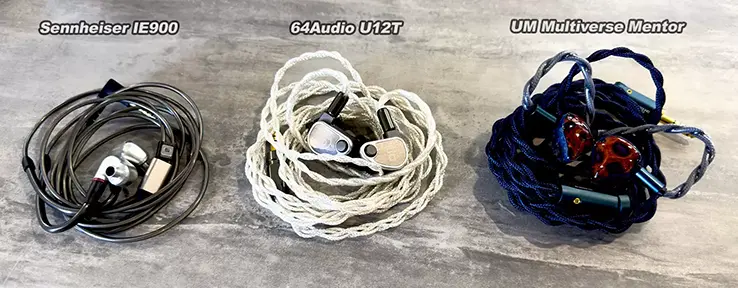
Sennheiser IE900 (USD $1500)
Though remarkably comfortable with their tiny shells, the IE900s are so small I have difficulty maintaining a seal as they’ll occasionally fall out. This can be alleviated with a different choice of eartips, but then those must be selected for fit rather than sound.
What was immediately evident in this comparison was how much difficulty a single dynamic driver has keeping up with a modern hybrid, and yet to my ears sounded no more coherent which was once the great advantage of single driver IEMs.
Compared with the Impacts the IE900s had a similarly wide soundstage and terrifically textured DD bass, but it was all downhill from there. Overall note weight was lower and this was particularly evident in the treble, resolution was lower, imaging was poorer, and even the bass felt less impactful though the DD slam was certainly there.
64 Audio U12T (USD $2000)
The U12T feature a drier, flatter presentation with more upper midrange emphasis. I found them to have a slightly wider but shallower stage than the Impacts, marginally higher resolution but much poorer dynamics.
Though U12T have fantastic bass for an all-BA IEM, the Impacts have higher bass quantity and more impressive bass texture which felt closer to that of a dynamic driver. Vocals on the Impacts also felt more forward and rich, and overall the U12Ts were a lot flatter & less energetic by comparison. The U12T shells were appreciably smaller but their shape did not match the curves of my ears as snugly as the Impacts.
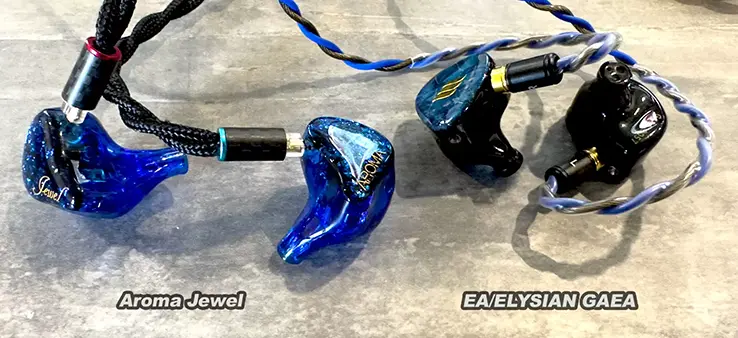
Effect Audio / Elysian Gaea (USD $1300)
Gaea was another IEM I had limited time with, having not been impressed with them previously. Their shells are slightly bigger than Impacts’ but were not uncomfortable in my ears.
Despite their similarly wide stage to Impact’s, Gaea fared worse in most other areas with a strong upper midrange emphasis many find polarising, much poorer note weight, and lower resolution across the board.
Gaea’s DD bass was pleasant but did not stand out as better than adequate and though Gaea are fantastic to look at with a surprisingly light & pliable stock cable, they were clearly outclassed by Impact.
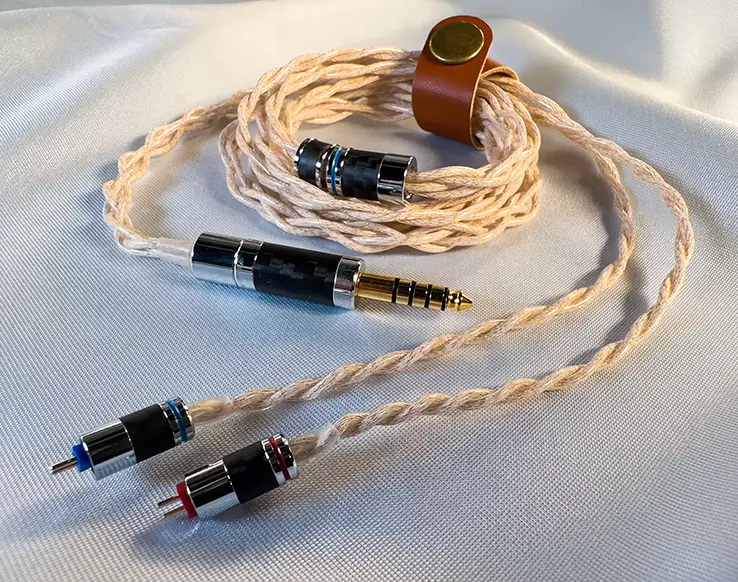
Cable Comparisons
I also used Saturday’s Melbourne Head-Fi meet to test Impact with a number of cables. Each one was compared with my Ares S 4 wire cable, since the Impact stock cable had issues at the time.
Penon Obsidian (USD $150 – Impact stock cable)
Regrettably my experience with the Penon Obsidian stock cable was not positive. Arriving with a modular plug system, after only several plug swaps it quickly developed a fault in one channel which would then cut out intermittently when the cable was handled.
To Penon’s credit they immediately shipped out via DHL a replacement cable (with a fixed 4.4mm plug at my request) that has since worked perfectly, and were generous enough to include a pair of Totem Adapters free of charge which I’ll discuss later. I’d encourage prospective Impact owners to avoid the modular plug system.
Sonically the stock cable has been a mixed bag. It’s very midrange focused, as is sometimes the case with gold-plated cables, imbuing vocals with a further sense of richness and presence that’s admittedly quite alluring and seductive.
The issue lies with the Impacts already possessing a midrange focus which many listeners may feel does not require further enhancement. Furthermore the stock cable does little to expand the soundstage which leave it feeling… I hesitate to say cramped but certainly narrower than one may find in IEMs of similar price. If much of your listening is vocal-centric music the stock cable may be an excellent choice, if not you may be left feeling it does not maximise Impacts’ soundstage, imaging & dynamics quite enough. It is “only” a $150 cable after all, and the following comparisons convinced me the Impacts scale so impressively that a more extravagant choice is warranted if your budget allows.
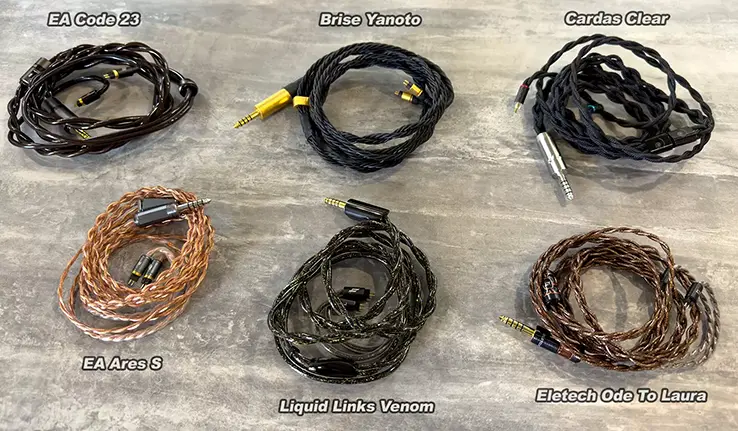
Effect Audio Ares S 4 Wire (USD $180)
Ares S had a greater upper midrange emphasis than the stock cable and created a more dynamic and energetic presentation.
Though the soundstage wasn’t necessarily wider it did feel more open & less sharply delineated between left / middle / right than the Obsidian, and as a consequence not as congested. Ares S has become my preferred Impact pairing between those two cables.
Eletech Ode To Laura (USD $2800)
I didn’t have a great deal of time with this particular cable but noticed it was appreciably brighter than the Ares S, with even more upper midrange emphasis that I didn’t expect from a copper cable. Ergonomically it was also very comfortable.
Brise Audio Yatono 8 Wire Ultimate (USD $2540)
In many ways this cable was the star of the shootout, altering the sound more dramatically than any other tested. Having said that the Yanoto did not synergise quite as well with Impact, but demonstrated how superbly it would pair with brighter IEMs in particular.
Yanoto was the second stiffest cable behind Code 23, but definitely the heaviest. It was difficult not to be aware of the weight, though I’d happily attempt to live with it for the incredible sound it delivered.
This cable created an enormously wide holographic soundstage with unbelievably precise imaging, on par or better in this regard than Chiron though I didn’t compare them side by side. It also created the illusion of being seated further back from the performers on stage.
Yanoto’s real magic lied with the unbelievably smooth liquidity it imparted on the presentation, creating a luxurious feeling of refinement no other cable could match.
Effect Audio Code 23 (USD $600)
Definitely one of the most interesting cables to hit the market recently, utilizing mammoth 16.5 AWG solid core copper, Code 23 was as heavy as one might expect but the real issue was stiffness – in the earhooks particularly.
This rendered the cable one I would not consider purchasing for comfort reasons alone, a pity because Code 23 delivers a massive holographic soundstage and a very rich, forward midrange.
Indeed soundstage expansion was right up there with cables costing thousands of dollars, though Code 23 felt a notch behind them in resolution. Still a superb option if you can live with the ergonomics but I suggest trying before buying.
Liquid Links Venom (USD $1090)
Visually distinctive and with better ergonomics than Code 23, being much less stiff and also lighter, some have complained Venom’s insulation can feel ‘sticky’ like TPU cases or Azla Xelastec eartips but I did not notice this in my short time with it.
Venom’s soundstage was slightly smaller than Code 23’s yet still very wide and noticeably deep. Vocals stood out as being enjoyably meaty and the cable seemed to synergise quite well with the Impacts.
Compared with Ares S, Venom delivered a smoother presentation yet despite that delivered superior resolution, with punchier midbass & greater midrange detail. Venom was my second favourite Impact pairing after Chiron.
Effect Audio Chiron 8 Wire (USD $3000)
Chiron deserves special praise for its’ ergonomics, being remarkably flexible and surprisingly light for such a high-end 8 wire cable, although I did find its’ earhooks a tad stiff. Coupled with its’ performance, if price were no object I would choose it on that basis alone.
Chiron’s stage was as wide as any cable tested, resolution as high or higher than any tested, and the tight & punchy bass it delivered was spectacular. It paired brilliantly with Impact, no surprise as I find it difficult to imagine it complementing any IEM poorly.
DIY Cardas Clear – Clone of PWAudio 1950s (USD $2150)
This DIY cable was built from the same Cardas Clear bulk wire PWAudio reputedly use in their 1950s cables, and according to those who’ve heard both sounds almost identical.
I found the Cardas Clear cable very close in performance to Venom, with slightly less ergonomic weight & stiffness. Both cables possessed a similarly-large soundstage, however the Cardas Clear drew extra attention to the midrange (and particularly lower midrange) and in doing so delivered extremely smooth, seductive vocals.
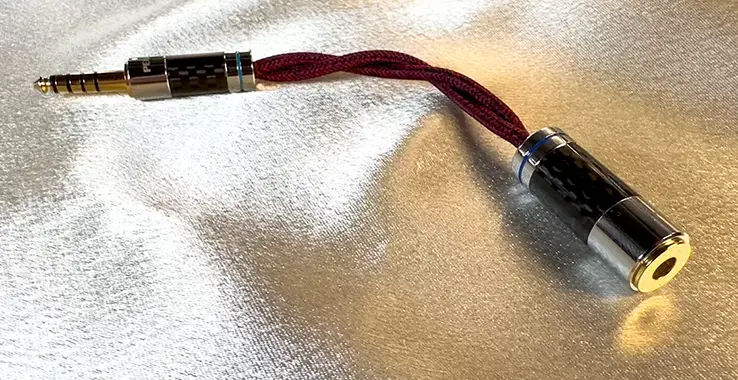
Penon Totem 4.4mm Pigtail Adapter (USD $85)
Penon sent me a 4.4mm Totem Adapter with the replacement Obsidian cable and though I didn’t find its’ sonic changes quite as dramatic as swapping entire cables, I was surprised by the improvements it made paired with Ares S and Cayin N8ii.
The adapter added a small amount of extra height & width to the soundstage, dynamics improved, the presentation felt a bit more energetic with extra detail throughout the midrange and treble, though perhaps adding a touch of dryness. These changes were very minor individually, but in totality made quite a difference especially given the adapter’s modest cost.
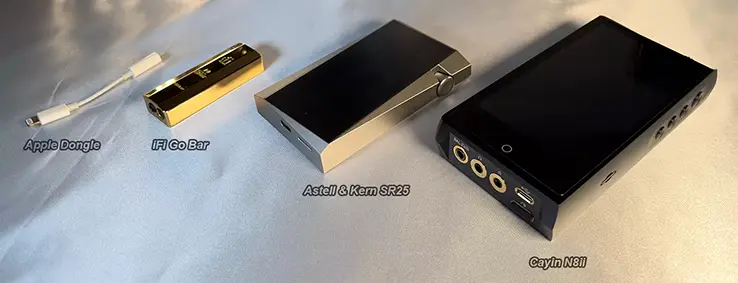
Source Comparisons
Keen to discover how the Impacts scaled with better sources, I tested them with those on hand.
Apple Lightning To 3.5mm Adapter (USD $10)
Though musically enjoyable through the Apple dongle, much of the Impacts’ potential remained unfulfilled as expected.
Dynamics were poor, the soundstage was compressed and imaging felt very blurry, resolution was noticeably lower that the other sources and bass was decidedly one-note with a lack of texture. The jumbled nature of the sound made picking out individual instruments difficult & fatiguing.
iFi Go Bar 10th Anniversary (USD $500)
The Go Bar was a massive improvement with a much richer midrange, hugely improved resolution, a wider and deeper soundstage, better dynamics and a greater sense of ease in which the music seemed to flow better.
The Go Bar’s biggest weakness was fairly audible background noise/hiss, more so than the other three sources in this comparison.
Astell & Kern SR25 (USD $600)
The SR25 synergised particularly well with the Impacts, better than the N8ii in some respects.
Sub bass impacted more deeply than the Go Bar, with better overall note weight and a greater lower midrange emphasis that made vocals in particular much more lifelike. Treble detail was not quite as emphasised however, but the presentation felt more organic since the Go Bar can lean towards feeling somewhat digital.
Cayin N8ii (USD $3500)
The N8ii was a big step up from the SR25 in all technical areas. Notes felt more solid & well-defined without losing detail, the background between instruments was blacker, soundstage was wider (though perhaps slightly flatter) and imaging improved.
Hearing the echoing decay of notes was easier, and the entire presentation felt more refined & effortless despite resolution increasing. Bass texture was also improved.
Swapping to the far more expensive N8ii from the SR25 yielded a much more refined sound, but did not increase my musical enjoyment as much as expected, cementing the belief that source, IEM & cable synergy remains paramount.
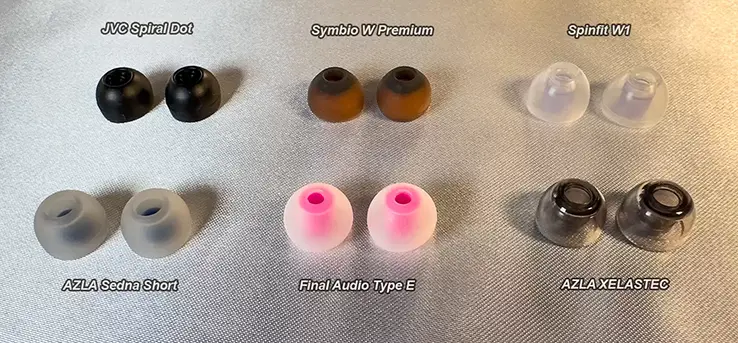
Eeartip Comaprisons
The Impacts have reasonably short but wide nozzles containing no less than 4 bores. I didn’t have issues with eartips coming loose in my ears thanks to their nozzle width, and although different eartips altered the sound the Impacts did not feel as eartip-sensitive as many other IEMs.
Spinfit W1
My current reference and default tips of choice. Their ability to improve sub bass impact versus any other eartip I’ve tried has been a revelation. On the Impacts they also added a tiny bit of treble sparkle.
Final Audio Type E
These were almost as comfortable as W1s and added a little more midbass but less sub bass as expected. Dynamics seemed to decrease marginally and the soundstage was slightly more intimate.
Azla Xelastec
The seal was quite good with these but I did not find them comfortable. For some reason they sounded a tad hollow with a lack of midbass presence.
Azla SednaEarFit Short
Possibly the second best seal behind the W1s, they sounded slightly airier with a nice overall sonic balance but less bass presence.
JVC Spiral Dots
Perhaps the most comfortable eartips or at least on par with W1s, they sealed surprisingly better than I find them doing with many other IEMs perhaps due to the Impacts’ comparatively wide nozzles. Bass presence was down compared with Sedna Shorts, placing more emphasis on higher frequencies.
Symbio W Premium
These were not quite as uncomfortable as I’ve experienced them being with other IEMs but still sealed poorly, sounding very airy and somewhat incoherent.
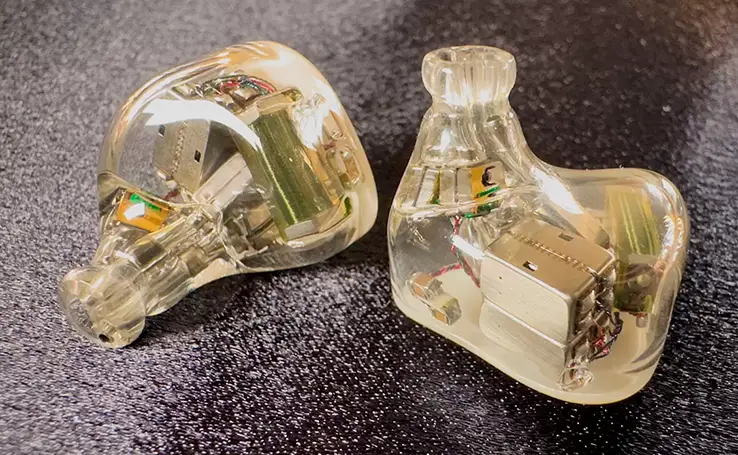
Conclusion
I’ve thoroughly enjoyed my time with the Impacts.
Traillii’s popularity strongly suggested a viable market for a cheaper alternative, and some of us are surprised it has taken this long for one to emerge. The other day a friend joked that perhaps Penon can expect to receive a letter from Oriolus’ lawyers, to which I responded by asking if it’s possible to patent an earphone’s tuning? That seems unlikely, and this is hardly the first time a winning formula has been borrowed.
The question is do the Impacts have what it takes to emerge from underneath Traillii’s very long shadow? I’m not sure how such a thing should be measured – in unit sales, volume of community commentary, or simply the enjoyment they bring each owner? This is a fabulous IEM in its’ own right, but it will be difficult to escape Traillii comparisons.
Putting that aside, the Impacts represent Penon’s first foray into truly high-end price & performance territory. All of us in Melbourne who heard the Impacts on Saturday agreed not only do they truly belong in the company of other summit-fi IEMs, but are quite possibly the most affordable way to join the conversation. This is of course contingent on the Impacts’ sound signature being to one’s particular liking, and the lack of a dynamic driver being something you’re willing to live with. Traillii’s popularity suggests no shortage of us will answer yes to both.
So to return to my original question: “what makes a great pair of earphones great?”
I can’t speak it, but the Impacts whispered it to me.

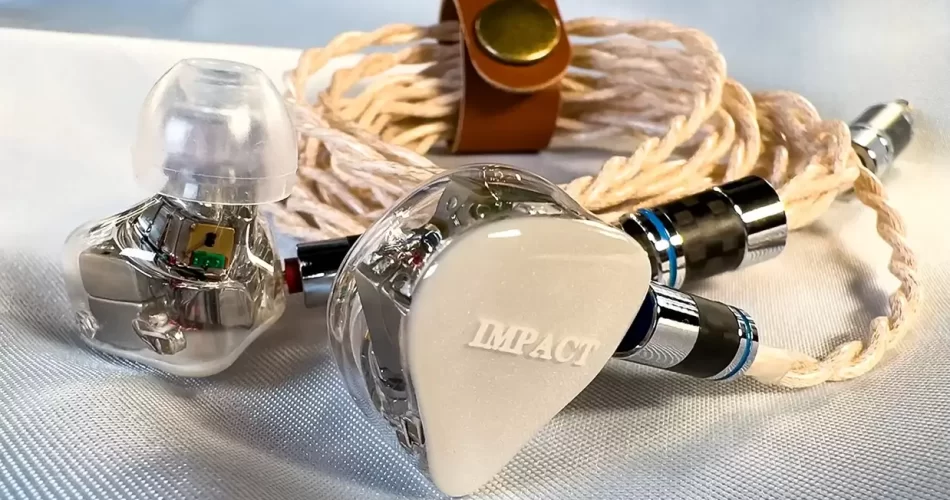
“I would nominate Impact’s BA bass of the best attempts so far but some Head-Fiers insist on DD bass and will accept no substitute”
I had the u12t and u18t. Your impressions on the 12t are spot on. It wasn’t the letdown, the ba receiver bass but rather the presentation, drier less engaging overall, they’re quite detailed though.
I kept my W50 for ba receiver bass qualities and employ my own hybrid ear tips for maximum thump. I created the same and was using this pair even before mandarin tips were available.
Excellent review and thanks for sharing…
I know exactly what you mean benj!
BA bass isn’t necessarily “bad”, I think different would be a better description. In fact for some genres having faster bass notes is a distinct advantage, but there are definitely times I’m left wanting for a more visceral experience only possible with slower DD bass decay.
Adding an external portable amp can improve BA bass texture & quantity and lead to a more satisfying experience I find. Swapping to an 8 wire cable or any cable that enhances bass presence can also be a minor improvement.